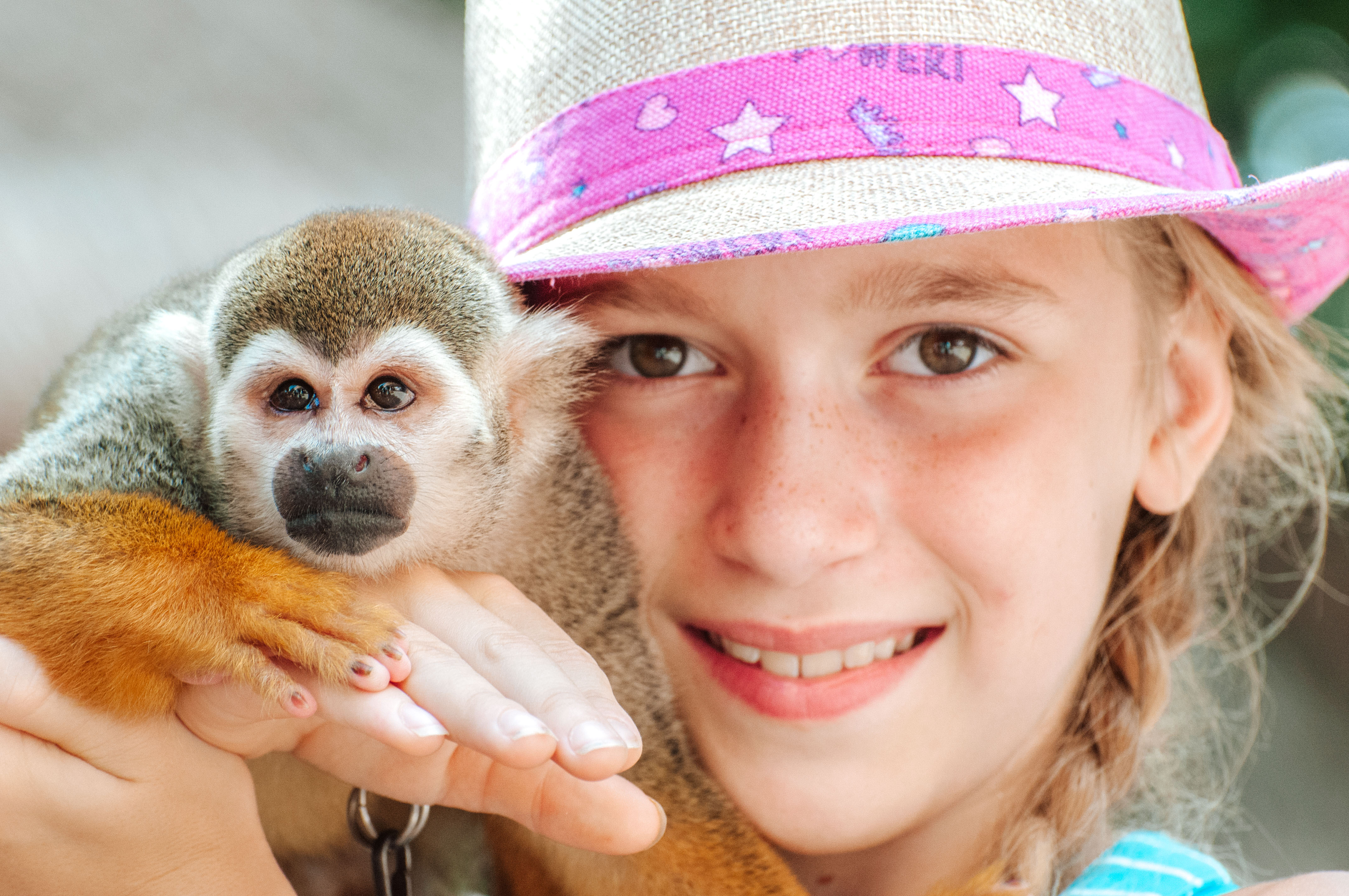
Things to Do in Riviera Maya and Yucatán
4- to 5-Day Itineraries . Hiking . Mexico . Outdoor Recreation . Travel . Worldwide Travel
4 Perfect Days in Mexico’s Riviera Maya and the Yucatán Peninsula
What are the very best things to do in Riviera Maya and the Yucatán?
Click on any day below or keep scrolling to find out!
Things to do in Puerto Morelos Mexico
- Stop by the town of Puerto Morelos for great local food and shops
Mayan Palace & Grand Mayan
- Settle in to the resort and check out the enormous complex of swimming pools
- Access sandy beaches and water sports along the Caribbean
- Choose from a great selection of restaurants at the resort
Tulum Ruins
- Enjoy breakfast downtown Tulum
- Visit the Mayan ruins at Tulum overlooking the beach
The Best Beach in Tulum
- Relax at Playa Paraíso
Cobá & Pool Day
- Bicycle through the Mayan complex of Cobá
- Hike to the top of a dizzying pyramid
- Head back to the Mayan Palace to sip piña coladas at the resort’s luxury club
Chichén Itzá and Ek Balam
- Drive through Valladolid and Ek Balam
- Walk through the impressive complex at Chichén Itzá
Planning a trip soon? Use our links to get discounted tickets, rental cars, and more! Our site is partly supported by affiliate partnerships; your purchases through our affiliate links help support our site and the development of even more great content!

You’ve probably seen dozens of vacation packages to Cancún, Playa del Carmen, and the Yucatán Peninsula. Whether you’re wanting a more rugged backpacking and hiking trip to ruins in the lowland jungle or a leisurely resort stay, it’s daunting to try and pick through all the options to plan the perfect itinerary.
That’s where we come in; we’ve been back and forth to the Yucatán dozens of times, starting when Ben lived in Central Mexico and right up to the present. Michelle and I have done every type of trip you can think of, from rugged backpacking (and Ben’s inadvertent night on an ancient pyramid) to luxury resort accommodations between Playa del Carmen and Cancún. And now, we’ve put together some of our favorite stops and activities to help take the hassle out of planning your next trip to the Riviera Maya.
Our “Best of” itinerary for Riviera Maya includes four full days of activities, packed with fun things to do in Riviera Maya and Yucatán. Click on any of the days in this itinerary to open up the full guide for that day, or use this consolidated guide as a starting point for your own Mayan Riviera adventure. Plan extra days for travel to and from Cancun, and feel free to extend your time in the Yucatán Peninsula, because once you get here, you’ll never want to leave!
Things to do in Mayan Riviera and Yucatán – Day 1: Puerto Morelos Mexico
Visit Puerto Morelos for Local Food and Shops
Whenever we first touch down in Mexico, we like to stop somewhere close by for a bite to eat, a walk around, and a quick stop for a few supplies and snacks at a local grocery store. Downtown Cancún is busy and fun if you’re staying in or near the Zona Hotelera, the long strip of hotels and restaurants on the beachfront property separated from Cancún proper by a large marshland. If you’re headed further South, stop by Puerto Morelos, about 20-25 minutes from the Cancún International Airport.
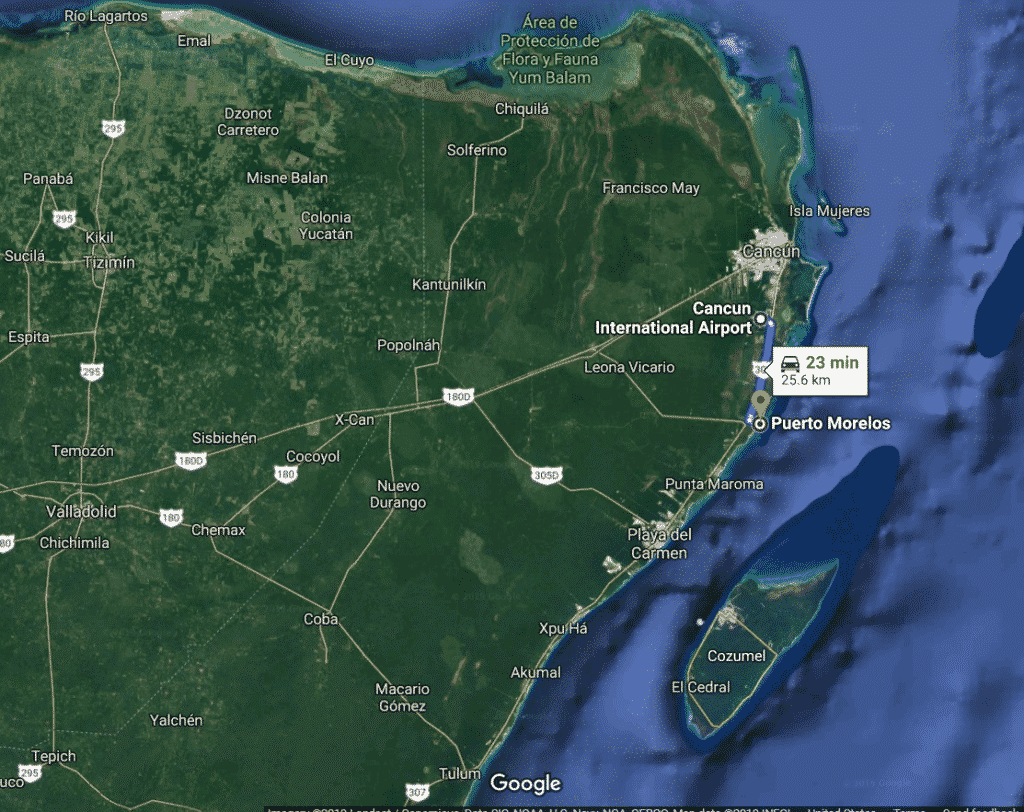

Throughout Mexico, the central plaza is called a “zócalo”, a Nahuatl word for gathering place. Puerto Morelos’ zócalo is broad and open, with a small playground on one side and cobblestones leading to a unique fountain with a miniature replica of Kukulcán, the principal Mayan pyramid at Chichén Itzá, in the center. Across the street you’ll find restaurants and shops with reasonable prices and a variety of both touristy items and more practical supplies. Puerto Morelos is also a great place to stop on the way back to the airport to buy those last-minute gifts for friends and family. You can usually get a better deal here than in many of the bigger areas like Cancún and Playa del Carmen.

Even small towns like Puerto Morelos have benefited from tourism dollars and pesos; the broad, paved waterfront walkway, the wooden piers, and the zócalo in the center of town have all been recently updated, and even the more established restaurants and shops that pre-date the current growth cycle have fresh thatched roofs and other improvements. We stopped by Pelicanos, a restaurant with a view. The restaurant serves regional favorites and some of ours, like chilaquiles (red- or green-sauce covered chips with cotija cheese and shredded chicken) and huevos rancheros, a tasty combination of homemade tortillas, beans, eggs, cheese, and chile sauce.
Things to do in Mayan Riviera and Yucatán – Day 1: The Mayan Palace and Grand Mayan Resorts
The Best Swimming Pools in Yucatán: Mayan Palace for the Win
For our Riviera Maya stay, we picked the Mayan Palace/Grand Mayan, a massive complex that uses its own internal shuttle carts to move people around the property. We’ve been here before, when the resort was just being built. Aside from the main pool and central building facilities, the resort is almost unrecognizable after nearly two decades of development.
The resort features various swimming pools throughout the property, including a narrow “river” that connects the upper pools to the lower pools. The water flows past enormous statues stylized with Maya iconography and hieroglyphics. The enormous series of swimming pools at the center of the property facing the beach includes swim-up bars, pool-side thatched-roof shelters available to rent, and everything from water volleyball to shallow wading pools for the littlest swimmers. (I still don’t trust the whole swimming diaper thing, but I’ll save that for another time).

The beach sits just a few steps from the main pools, rocky in places and sandy in others. After a few hours of pool time (and a short nap for Renn and me), we wandered back down to the beach, where the girls searched for sea creatures and shells and other treasures. Piers extend from the beach out into the Caribbean Sea, and further down, Sea-Doos and other equipment can be rented for the day or by the hour.

Things to do in Mayan Riviera and Yucatán – Day 2: Tulum Ruins


After our refueling stop in town, we headed to the zona arqueológica de Tulum, an ever-developing historical and tourist site. As with any development, there are pros and cons that come with growth. On the positive side, the site is more accessible and better maintained than ever before. The downside of massive crowds is offset somewhat by the revenue brought in by tourism that funds further preservation and development of the site. Regardless, if you get there early, you’ll have the place to yourself. Most tour buses and larger groups start to arrive closer to 9 or 10 am. You can even take a dip in the Caribbean below El Castillo before most people have made it through the ticket line if you plan it right.
The shops and restaurants outside the main complex have grown exponentially over the past 20 years, and the commercial entrance feels very different than the stark stone complex inside the archaeological zone. The truth, though, is that this new development is only different in scale; markets have always existed on the fringes of ceremonial complexes, even here at Tulum long before the Mayan site declined. I suppose the difference today is that instead of bartering for hand-made goods and home-grown produce, you can grab a Starbucks on your way in to the ruins and get your photo taken with adorable creatures for a not-so-adorable fee. (You be the judge whether it was worth the cost!)
The Most Stunning Ruins in Yucatán: Tulum
Tulum is one of many Mayan sites located on the Yucatán Peninsula. Chichén Itzá is probably the best-known site, and served as the most important power center for several hundred years before the Spanish arrived. But Tulum was no less important in terms of its location on the coast and trade with settlements further South into present-day Belize and other parts of Central America.
Tulum centers around the main structure, El Castillo, the impressive stone structure that sits perched on the cliff overlooking the Caribbean Sea. The other main buildings radiate out from there, with smaller outbuildings flanking the Castillo and many others surrounding them further away from the ledge. (If you’re interested in our quick reference guide for the main structures at Tulum, I’ve included a full list at the very end of our Tulum photos).

Tulum Pro Tips: What To Do (And What Not To Do)
What about the crowds and swimming beneath the ruins and whether or not to hire a guide?
As I mentioned before, arrive as early as possible to avoid the majority of visitors who arrive after 9:30 or 10 am. Despite what you may think from my carefully-composed images, Tulum can feel absolutely overrun by tourists, depending on the time of day. The tranquil, awe-inspiring locale can begin to feel much more frantic and harried the longer you wait to get there. I love a good crowd, but when it comes to Tulum, less is more. Plan to arrive about 15 minutes before the site opens, and you’ll feel like you’re the only one there.
It’s fun to swim on the beach below the ruins. I like to imagine what it must have been like to swim below the Castillo in A.D. 1220 or 900 or even earlier, long before archaeologists would unearth the ancient structures and tourists would swarm the site sipping on iced lattés and complaining of the tropical heat. If you arrive early and tour the site first, you’ll also have time to take a dip before most people hike down to the narrow beaches below the ruins.
And what about hiring a guide or joining a tour group for a guided tour of the site? We’re big fans of local guides, for several reasons. One, many guides are Mayas and have a deep connection to the land, the site, and the history of Yucatán. It’s worth the time and added expense to hear their stories and understand Tulum from their perspective. Two, hiring local guides benefits the local economy and local communities directly; your entrance fee supports the development and preservation of the site, but hiring a guide is a fairly inexpensive way to support local entrepreneurs. Three, you’ll learn way more about Tulum with a guide than on a self-guided tour, and you’re likely to hear some interesting stories and perspectives that you won’t find in any brochures or printed site guides.
That said, we also recommend buying a printed site guide at the bookstore, here and at all the other sites you visit. Guides are written by archaeologists and researchers who have labored at the sites for decades, and are available in many different languages. We suggest buying a guide for each site you visit and then reading through each one later; it’s fun to read more about the buildings and areas you’ve seen first-hand, and you’re more likely to remember the information when you connect what you’re reading with your photos and memories of the actual site.
What Were the Buildings at Tulum Used For? Here’s the Mod Fam Quick Guide:
- El Castillo – The principle building overlooking the sea, El Castillo, stands 12 meters (39.37 feet) high above its base, far above the sea below. Built over successive periods, the Castle contains sculpted images of the Plumed Serpent, Chac (god of rain), and a crocodile. A (possibly) sacrificial altar sits at the top of the staircase.
- House of the Cenote – This structure is built directly over a freshwater well, and served to collect rainwater.
- Temple of the Wind – This temple overlooks the sea, to the North of el Castillo. Like the other temples to the South, the Temple of the Wind has a single entrance and a small altar, and relates to Ehécatl-Quetzalcóatl.
- Casa de Halach Uinic, House of the True Man – This term referred to royalty for the Maya of Yucatán. This building used to contain extensive murals and a large, thatched roof, as well as various references to the Descendant God.
- House of the Columns – The Casa de las Columnas is the largest residential space at Tulum.
- Temple of the Murals – This temple served various social and religious functions, and sits at the center of the main complex. The temple was constructed during various periods, and a monument from Tankah sits to one side of the building. Murals depict Chac (god of rain) and Ix Chel (goddess of the moon, medicine, birth, and sewing). Other depictions relate to agriculture and fertility cults.
- Temple of the Descendant God – In the Northeast corner of the inner zone, the Templo del Dios Descendente consists of two constructions, the earlier base and the later temple, erected with ornate sculpture and elegant roofing. The representation of the deity looks to be rappelling from the sky, and may represent the Venus cult, or deities related to rain, the morning or afternoon sun, swallows, or bees.
- Temple of the Nauyaca – This temple, together with the Temple of the Sea further South, completes the line of temples facing the sea.
- Temple of the Sea – The Temple of the Sea has a single entrance to a one-room space with a small altar. This building is characteristic East Coast, facing the sea, and sits at the far end of the main complex, furthest South.
(Information from Martos, Luis and Alejandro Martínez. Yucatán: Arqueología, Arte, Tradiciones. México, D.F.: Monclem Ediciones S. A. de C.V., n.d.)

Things to do in Mayan Riviera and Yucatán – Day 2: Playa Paraíso
The Best Beaches in Tulum: Playa Paraíso
No matter how engaged and interested a visitor you are at the ruins of Tulum, your mind and body will need a break after taking in all that the archaeological zone has to offer. That’s why we recommend Playa Paraíso, quite possibly the most perfect white sand beach in all of Yucatán. And that’s saying something, because we’ve been to a lot of beaches in Yucatán. And this beach is incredible. Paradise Beach is so beautiful that these photos required no editing; I literally could not improve on the natural beauty of Playa Paraíso. If for no other reason, plan to spend the afternoon here because it is likely to create a strong sense of pure joy and elation, no matter your prior mental state. There is a reason it’s called paradise; you don’t need to look any further to find the perfect beach.
Take our word for it: Playa Paraíso is the BEST beach in all of Yucatán. I suppose you might be able to scout out a secluded cove in an untouched corner of the Mayan Riviera, but those spots are few and far between. Paradise Beach has a good mix of wide, open white sand beach, a few restaurant options nearby, and a relaxed vibe without the crowds you’re likely to get in Playa or Cancún. And even though nothing can beat the feel of Costa Rica’s chill surfing beaches, this is a close second.

Things to do in Mayan Riviera and Yucatán – Day 3: Cobá Ruins & the Grand Mayan
As you can see on the satellite map below, there are several routes to Cobá from The Grand Mayan and Playa del Carmen to the South. The fastest route takes you South through Tulum and then back Northwest to the site. Depending on your plans and time along the Mayan Riviera, you may want to see both Tulum and Cobá in one day. There are pros and cons for seeing Tulum first and vice-versa. On the one hand, getting to Tulum when it opens is always the best way to see that site, but then you’ll be visiting Cobá later, in the heat of the day. The climb to the top of the main pyramid is hard enough in the cooler morning; we made the climb in the afternoon heat and paid the price in sweat and discomfort! On the other hand, if you drive to Cobá to start the day in the cooler temperatures there, by the time you get back to Tulum, it will likely be much more crowded and less enjoyable. So, our recommendation is to visit Cobá on another day entirely, even though you may have to drive back and forth a little more than you would if you combine the sites into a single day.
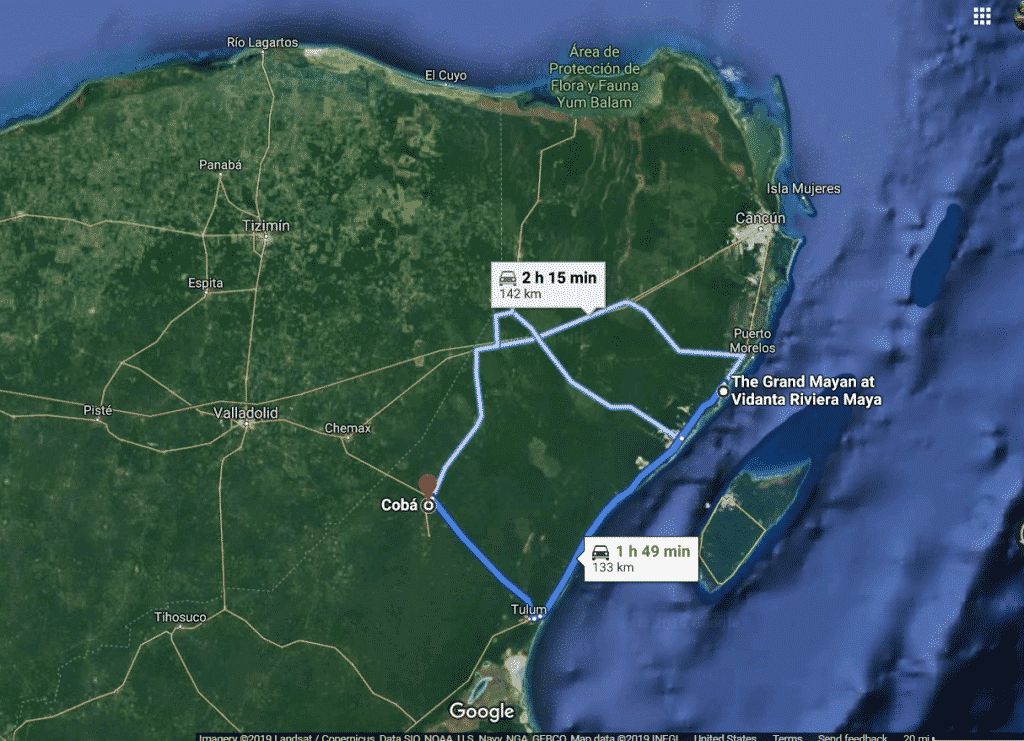

The Best Way to See Cobá: Bike the Ruins
The dirt and gravel paths throughout the complex at Cobá are wide, broad, and flat, making them perfect for the site’s many rickshaws and bicycles available to rent for a nominal fee. Sections of the broad walkways are actually part of a much longer system of ancient roads built by the Mayas of Yucatán to connect various sites to Cobá, a Yucatecan version of the Roman roads.
Here, as in Tulum and Chichén Itzá, you will be faced with the inevitable questions of visiting historical ruins in Yucatán: should you hire a local guide, buy a self-guided tour book, or just wing it, and hope to glean something valuable from just being there, soaking up the views of ancient stone ruins and the ball court and the pyramid towering over the lush jungle below? As we mentioned yesterday, hiring a local guide is a worthwhile expense and a small way to give back to the local Maya communities that live and breathe these spaces as they have for thousands of years. Even if you wander around on your own afterward, it is well worth talking with a guide and hearing Maya perspectives on the history and significance of Cobá.
We biked and rode through Cobá, stopping at various structures and excavated sites, like the relatively small ball court that has a small earthen strip between two steep stone embankments leading to two carved stone rings on either side of the court. Although the ball court in Chichén Itzá is much larger (and the largest in all of Mesoamerica or “Middle America”), the court at Cobá is striking because of its scale, design, and setting. The angled sides and embedded rings make this a unique and significant example of the ancient ball games.

Climb a Pyramid in Yucatán: Cobá
There was a time when you could scale Kukulkán, the massive pyramid at Chichén Itzá; injuries from tourists falling down the incredibly steep steps have put an end to that (more on that tomorrow). So if you want to climb high above the jungle canopy, opt for Cobá or other sites further North.
A long rope down the center of the staircase offers a little support for your climb, but be careful; these steps are steep. And by steep, I mean about the width of an adult shoe – sideways. The steep pitch of the stone staircase creates an almost vertical ascent at more than a 45-degree angle up. One misstep and you could tumble all the way down the enormous structure.
There really is nothing as awe-inspiring as standing atop an ancient ceremonial pyramid like this, looking out over the jungle as far as you can see, a sea of dark green under the afternoon rain clouds gathering before a storm. And then, just when you think the heat and humidity are unbearable, the clouds give up the rain, cooling the air in yet another cycle of rain, seepage through the limestone shelf to the freshwater rivers below the surface, evaporation, rising humidity, and torrential rain. We made it back down the pyramid and back through the complex before today’s rains, but I’m pretty sure we felt the full brunt of the sun standing atop the pyramid.

If you make your way up the pyramid, be careful and take the ascent and descent slowly. If you have children with you, be doubly careful. It’s worth sharing the experience with little ones, but just be aware of the risks and don’t attempt something that you – and they – are not comfortable doing.
Back to the Grand Mayan: Must-See Luxury Pools
By now, you’re probably starting to see a pattern in how we like to explore: start early with an historical tour, visit the ruins, or otherwise do something active, and then follow that up with a relaxing afternoon and evening. With younger (young-ish?) kids, this feels like a good pace, and we can spend time doing what we all enjoy without overdoing it or going so fast and furious that we’re all worn out after our vacation!
So what is our answer to ghastly heat and humidity out in the jungle? Cool water and piña coladas, of course! And judging by Renn’s yawn, a short nap under a few pool towels is also in order.
We are huge fans of the Grand Mayan and Mayan Palace, for reasons we mentioned our first day here. Two more new reasons to love the resort are the luxury clubs at either end of the property facing the beach. These newly-designed areas feature cozy pools that wrap around and between semi-private seating areas with privacy screens, umbrellas, and various levels of planters and other visual dividers. There are larger, open swimming areas and smaller, more private enclaves if you’re wanting to relax away from the crowds at the much larger (and much busier) main pools.

Things to do in Mayan Riviera and Yucatán – Day 4: Ek’ Balam & Chichén Itzá
Valladolid is the hub of the Yucatán, and has its own rich, storied history, from Pre-Colombian days to the present. Our two stops today, Ek’ Balam (both the village and the excavated ruins) and Chichén Itzá are both about 30 and 45 minutes North and West of Valladolid, respectively. We’re heading through Valladolid for breakfast before walking around the ruins at Ek’ Balam. Then, we’ll have an early lunch back in town before spending the rest of the afternoon at Chichén Itzá.
In all the drive to all three spots will take about 6 hours of driving, round trip. Unless you plan to stay overnight in Valladolid, there’s really no way around that unless you book a tour and ride a tour bus or public transportation from Cancun or other tour stops up and down the coast.
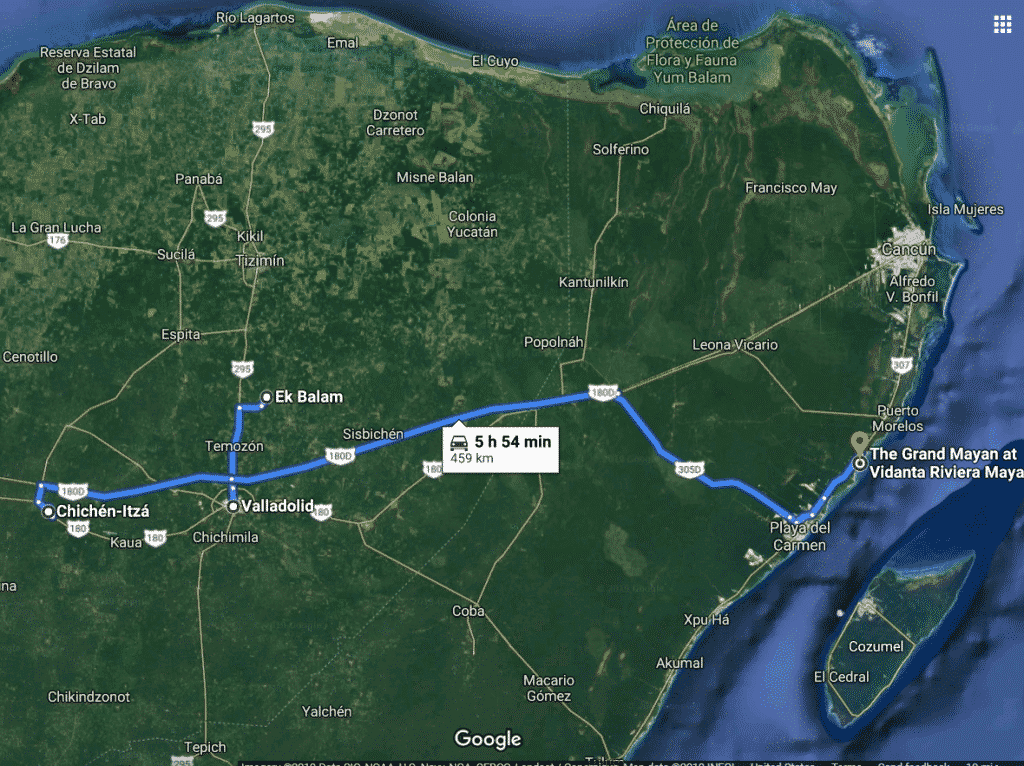

How do You Get to Chichén Itzá and Ek’ Balam? Through Valladolid, of Course!
The drive to the town of Valladolid is an hour and 45 minutes from the Grand Mayan, about two hours from Playa del Carmen. Valladolid is a bustling city with lots of shops and restaurants and other amenities. If you’d like a much more calm, rural town to wander through, check out the village of Ek’ Balam. Several eco-tourism lodges and hotels have opened up recently, and there’s a sustainable farm/retreat/yoga center run by a family that we met years ago on Isla Mujeres. She’s from Germany; he’s from Mexico. Together with their kids, they moved to Ek’ Balam to build a sustainable life for themselves and their guests. Maybe it’s the clear, freshwater cenotes of Yucatán or the warm air and tropical climate; Ek’ Balam and the surrounding area have a disproportionate number of eco-lodges and retreat centers, compared with the rest of the peninsula. Whatever the reason, you’ll have plenty to chose from, and you can book directly online with many of the lodges or through third-party booking agents like our affiliate partner, VRBO.
The Mayan ruins at Ek’ Balam may be less known than their nearby counterpart, but they are no less visually stunning and rich with history. A wide, ample ball court sits at one section of the complex, the primary pyramid structure visible just beyond a stand of trees at one end.

Like many of the other sites closer to Mérida (Uxmal, Sayil, and others), Ek’ Balam features partially re-constructed structures with few visitors and plenty of interior and exterior spaces to explore. You’re likely to encounter bats inside the open stone buildings; the sonic buzzing of my camera flash sent the bats flying in the small room below. Inside rooms like this one, you can see the narrow center stones that hold the rest of the roof in place. Both sides of the roof descend from the center line in a steep pitch, similar to a Roman arch, but without any curvature. This steep, high roof structure is called the Mayan corbeled vault, unique to the Mayas.
Continuing on to the main pyramid, you’ll see numerous thatched roofs lining both sides of the central stone staircase. Underneath are a treasure-trove of sculptures, hieroglyphics, and Mayan calendar inscriptions, expertly preserved and covered in a lime plaster. This is the type of original Maya artifact that you’ll see replicated endlessly at resorts and restaurants all around Yucatán and beyond. Ek’ Balam has some of the most significant and well-preserved examples of various carved images and hieroglyphic writing, so it’s definitely worth a stop and a climb up the steep steps.

The Largest Ruins in Yucatán: Chichén Itzá
During the summer and winter solstices, people flock to Chichén Itzá from all over the world to witness the shadows of the pyramid that appear to slither down the sides of the pyramid to the serpent heads that keep watch at the four corners of Kukulkán, the Castillo of Chichén Itzá. (You can watch the Smithsonian’s time-lapse video of the summer solstice “Descent of Kukulkán here). The pyramid is perfectly situated to replicate this effect twice each year during the solstices.
Kukulkán is the Maya variant of Quetzalcoátl, the Nauhatl name for the Plumed Serpent. This deity was one of the most significant deities in the Meso-American pantheon, owing to both ancient legend and myths of historical rulers. Quetzalcoátl/Kukulkán was considered the “morning star,” the creator of the Mayas and the Mexica, and alternatively, the deity of books, learning, and the priest caste. The Spanish and the Mayas alike re-interpreted the legends of Quetzalcoátl and Kukulkan to explain the devastating effects of the encounter between indigenous Mayas and Europeans settlers and conquerors (the Plumed Serpent came from the East, and had surprisingly European features, according to some legends). The so-called prophecy of European arrival as the “return” of the Plumed Serpent served to explain the devastation experienced by indigenous Mayas while justifying Spanish dominance in the region. Both groups benefited from this re-telling of ancient myth.
The first few times I visited Chichén Itzá, the top platform and ceremonial rooms were accessible to the general public. But an ominous sign suggested that dangers awaited the unsuspecting; an ambulance sat ready and waiting near the base of the great pyramid. In the years since, public access to the steps and viewing platform have been restricted, owing in part to the injuries and deaths of tourists who didn’t watch their steps.
Inside Kukulkán, earlier periods of construction are visible, and there’s even an interior staircase that leads to a lower platform with an ornately carved jaguar. When I last viewed this in 2002, the moisture in the completely non-ventilated space dripped from the ceiling and walls.

Circling around the main pyramid, you’ll come to a massive ball court with high, vertical walls and stone rings perched far above the surrounding field. This is actually the largest ball court in all of Meso-America, complete with multiple viewing platforms for royal observers, graphic carvings depicting sacrificial victims, and high stone walls that cast long shadows over the field.
The goal of the game was not only to pass the ball through the small stone rings on either side of the court, but to keep the ball moving back and forth in imitation of the planets and solar bodies. Each of the temples to the North and the South are decorated with different reliefs, some depicting families or clans, warriors, sacrifices, decapitation, and other practices.
The carved skulls are what the Aztecs called a Tzompantli or Row of Skulls. This carved version of the actual skull racks is a much more human-friendly version of the tzompantli found in Central Mexico.
Below, stone serpent heads protrude at the top of the platform of the Eagles and Jaguars. The platform base depicts different images, animals, and practices, like this eagle and jaguar eating human hearts.

Chichén Itzá Pro Tips: What To Do (And What Not To Do)
As I’ve mentioned the last few days, it’s well worth hiring a local guide for the mix of local knowledge and perspectives, and it supports Maya communities in the area directly. And just like Cobá and Tulum, we recommend buying one of the official site guides for reference and for future information. It’s pretty fun to read more in depth about where you’ve been, either by the pool, on the beach, or on your flight back home. The guides are written by archaeologists and researchers at the sites, so that’s the very best, most accurate source of information about the sites.
Because it takes a while to drive to Chichén Itzá (unless you’re staying in Ek’ Balam or Valladolid), just expect to get rained on at some point. Take an umbrella; even though the rain feels pretty good in the humid tropical heat, you don’t wan’t to spend the drive home sopping wet.
You can view the Gran Cenote at the site, but it’s not accessible like many of the clearer fresh-water cenotes elsewhere throughout Yucatán. Even though we ran out of time today, you could add on a refreshing stop at a nearby cenote, either here or closer to the coast.
Near the Temple of the Warriors, you’ll see the Temple of the Tables and Temple of Chac Mool. Murals in these temples depict jaguars and seated male figures on jaguar thrones. The Temple of Chac Mool is located beneath the outer structure of the Temple of the Warriors, and the Temple of the Tables sits just to the North of both, on a separate platform. The Group of a Thousand Columns flanks the three temples. This enormous, column-supported roofed area likely served some military or training function. More than 2,000 images of armed warriors mark each of the supporting pillars.
What is the History of Chichén Itzá, and What Were Chichén Itzá’s Buildings Used For? Here’s the Mod Fam Quick Guide:
During its various stages, Chichén Itzá represented a cultural fusion, and combines elements of various regions. Researchers first pointed out architectural connections between Tula and Chichén Itzá in 1887 (both have similar columned areas, spatial arrangement, relative location of the ball court, etc.) Sculptures, the reclining Chac Mool in particular, reinforce these connections between the Toltecs and Itzá of Yucatán. Significant debate over the source of these similarities (and their complete absence at sites between the two) continues to the present.
Between A.D. 800 and 1100, its area extended more than 25 square km., and served a population of more than 30,000.
The Maya of Yucatán were overrun by Central Mexican groups (likely the Toltecs) after A.D. 900. These groups ruled from Chichén Itzá until about A.D. 1200-1250, and brought with them many of the practices and iconography of Tula and Central Mexico (Chac Mool statues, pillared palace, warrior pillars, and a more intense focus on human sacrifice). After A.D. 1250, Chichén Itzá was abandoned, and Mayapán rose in prominence as Mayan lords again ruled the Yucatán. Mayapán, too, fell around 1450, and by the arrival of the Spanish, any regional authority (beyond the immediate, local level) had disappeared from Yucatán.
- El Castillo or Kukulkán – El Castillo rises 24 meters (78.74 feet) above the surrounding grounds. Large serpent heads adorn the base of the North staircase. Depictions of shells on the roof refer to the wind.
- Temple of the Jaguars – This temple sits at the far South end of the East side of ball court (not the South Temple). The interior depicts battle scenes in front of a small town.
- Ball Court, along with the North and South Temples – This ball court is the largest ball court in all of Mesoamerica, and dates to the Maya-Toltec Period of development. The goal of the game was not only to pass the ball through the small stone rings on either side of the court, but to keep the ball moving back and forth in imitation of the planets and solar bodies. Each of the temples to the North and the South are decorated with different reliefs, some depicting families or clans, warriors, sacrifices, decapitation, and other practices.
- El Tzompantli or Row of Skulls – The Row of Skulls is a copy of those found in Central Mexico (the Aztecs also had a number of skull rows or racks).
- Platform of the Eagles and Jaguars and the Platform of Venus – Near the ball court, both platforms depict different images, animals, and practices. The former depicts eagles and jaguars eating human hearts, while the latter depicts the plumed serpent with claws of a jaguar.
- Sacred Cenote – The sacred cenote of Chichén Itzá is a fresh-water well from which sacrifices and other offerings have been recovered. Most of the recovered sacrifices at this site were children, and other offerings include gold disks, jade, obsidian, wood, textiles, and shells.
- Temple of the Warriors – Small statues and a Chac Mool sit above the steps to the temple of the Warriors. This temple is visible from the Kukulkán Pyramid and the direction of the ball court. The jaguars, eagles, and mythical animal in the murals are all depicted eating a human heart. The Chac Mool at the top of the stairs may represent a mediator or intermediary between the Maya and the gods. Murals inside the temple depict daily life, human sacrifice, and battles.
- Temple of the Tables and Temple of Chac Mool – Murals in these temples depict jaguars and seated male figures on jaguar thrones. The Temple of Chac Mool is located beneath the outer structure of the Temple of the Warriors, and the Temple of the Tables sits just to the North of both, on a separate platform.
- Group of a Thousand Columns – This enormous, column-supported roofed area likely served some military or training function. More than 2,000 images of armed warriors mark each of the supporting pillars.
- The Market – Like the Group of a Thousand Columns, the Market was reserved for nobles or warriors, or both. It is not related to an actual market.
- The Observatory – The observatory was constructed at the height of Chichén Itzá, between A.D. 900 and 1100. Images of Chac adorn the building.
(Information from Keen, Benjamin and Keith Haynes. A History of Latin America. 8th Edition. Boston: Houghton Mifflin, 2009. López Austin, Alfredo and Leonardo López Luján. Mexico’s Indigenous Past. Norman: Oklahoma University Press, 2001. Martos, Luis. Chichén Itzá: Historia, Arte y Monumentos. Mexico, D.F.: Monclem Ediciones, S. A. de C.V., 2008.)



























































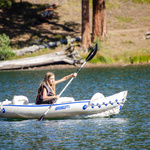
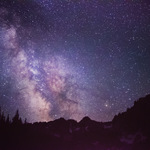
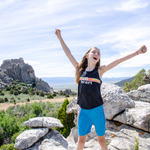
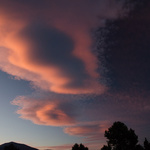

[…] Riviera Maya and Yucatán: 4 Days […]